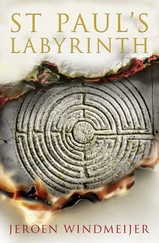Il Duomo — or, more formally, the Cathedral of Santa Maria del Fiore — in addition to providing a nickname for Ignazio Busoni, had long provided not only a spiritual heart to Florence but centuries of drama and intrigue. The building’s volatile past ranged from long and vicious debates over Vasari’s much-despised fresco of The Last Judgment on the dome’s interior … to the hotly disputed competition to select the architect to finish the dome itself.
Filippo Brunelleschi had eventually secured the lucrative contract and completed the dome — the largest of its kind at the time — and to this day Brunelleschi himself can be seen in sculpture, seated outside the Palazzo dei Canonici, staring contentedly up at his masterpiece.
This morning, as Langdon raised his eyes skyward to the famed red-tiled dome that had been an architectural feat of its era, he recalled the time he had foolishly decided to ascend the dome only to discover that its narrow, tourist-crammed staircases were as distressing as any of the claustrophobic spaces he’d ever encountered. Even so, Langdon was grateful for the ordeal he’d endured while climbing “Brunelleschi’s Dome,” since it had encouraged him to read an entertaining Ross King book of the same name.
“Robert?” Sienna said. “Are you coming?”
Langdon lowered his gaze from the dome, realizing he had stopped in his tracks to admire the architecture. “Sorry about that.”
They continued moving, hugging the perimeter of the square. The cathedral was on their right now, and Langdon noted that tourists were already flowing out of its side exits, checking the site off their to-see lists.
Up ahead rose the unmistakable shape of a campanile — the second of the three structures in the cathedral complex. Commonly known as Giotto’s bell tower, the campanile left no doubt that it belonged with the cathedral beside it. Adorned in the identical pink, green, and white facing stones, the square spire climbed skyward to a dizzying height of nearly three hundred feet. Langdon had always found it amazing that this slender structure could remain standing all these centuries, through earthquakes and bad weather, especially knowing how top-heavy it was, with its apex belfry supporting more than twenty thousand pounds of bells.
Sienna walked briskly beside him, her eyes nervously scanning the skies beyond the campanile, clearly searching for the drone, but it was nowhere to be seen. The crowd was fairly dense, even at this early hour, and Langdon made a point of staying in the thick of it.
As they approached the campanile, they passed a line of caricature artists standing at their easels sketching garish cartoons of tourists — a teenage boy grinding on a skateboard, a horse-toothed girl wielding a lacrosse stick, a pair of honeymooners kissing on a unicorn. Langdon found it amusing somehow that this activity was permitted on the same sacred cobbles where Michelangelo had set up his own easel as a boy.
Continuing quickly around the base of Giotto’s bell tower, Langdon and Sienna turned right, moving out across the open square directly in front of the cathedral. Here the crowds were thickest, with tourists from around the world aiming camera phones and video cameras upward at the colorful main facade.
Langdon barely glanced up, having already set his sights on a much smaller building that had just come into view. Positioned directly opposite the front entrance of the cathedral stood the third and final structure in the cathedral complex.
It was also Langdon’s favorite.
The Baptistry of San Giovanni.
Adorned in the same polychromatic facing stones and striped pilasters as the cathedral, the baptistry distinguished itself from the larger building by its striking shape — a perfect octagon. Resembling a layer cake, some had claimed, the eight-sided structure consisted of three distinct tiers that ascended to a shallow white roof.
Langdon knew the octagonal shape had nothing to do with aesthetics and everything to do with symbolism. In Christianity, the number eight represented rebirth and re-creation. The octagon served as a visual reminder of the six days of God’s creation of heaven and earth, the one day of Sabbath, and the eighth day, upon which Christians were “reborn” or “re-created” through baptism. Octagons had become a common shape for baptistries around the world.
While Langdon considered the baptistry one of Florence’s most striking buildings, he always found the choice of its location a bit unfair. This baptistry, nearly anywhere else on earth, would be the center of attention. Here, however, in the shadow of its two colossal siblings, the baptistry gave the impression of being the runt of the litter.
Until you step inside , Langdon reminded himself, picturing the mind-boggling mosaic work of the interior, which was so spectacular that early admirers claimed the baptistry ceiling resembled heaven itself. If you know where to look , Langdon had wryly told Sienna, Florence is heaven .
For centuries, this eight-sided sanctuary had hosted the baptisms of countless notable figures — Dante among them.
I shall return as poet … at my baptismal font.
Because of his exile, Dante had never been permitted to return to this sacred site — the place of his baptism — although Langdon felt a rising hope that Dante’s death mask, through the unlikely series of events that had occurred last night, had finally found its way back in his stead.
The baptistry , Langdon thought. This has to be where Ignazio hid the mask before he died. He recalled Ignazio’s desperate phone message, and for a chilling moment, Langdon pictured the corpulent man clutching his chest, lurching across the piazza into an alley, and making his final phone call after leaving the mask safely inside the baptistry.
The gates are open to you.
Langdon’s eyes remained fixed on the baptistry as he and Sienna snaked through the crowd. Sienna was moving now with such nimble eagerness that Langdon nearly had to jog to keep up. Even at a distance, he could see the baptistry’s massive main doors glistening in the sun.
Crafted of gilded bronze and over fifteen feet tall, the doors had taken Lorenzo Ghiberti more than twenty years to complete. They were adorned with ten intricate panels of delicate biblical figures of such quality that Giorgio Vasari had called the doors “undeniably perfect in every way and … the finest masterpiece ever created.”
It had been Michelangelo, however, whose gushing testimonial had provided the doors with a nickname that endured even today. Michelangelo had proclaimed them so beautiful as to be fit for use … as the Gates of Paradise.
The Bible in bronze , Langdon thought, admiring the beautiful doors before them.
Ghiberti’s shimmering Gates of Paradise consisted of ten square panels, each depicting an important scene from the Old Testament. Ranging from the Garden of Eden to Moses to King Solomon’s temple, Ghiberti’s sculpted narrative unfolded across two vertical columns of five panels each.
The stunning array of individual scenes had spawned over the centuries something of a popularity contest among artists and art historians, with everyone from Botticelli to modern-day critics arguing their preference for “the finest panel.” The winner, by general consensus, over the centuries had been Jacob and Esau — the central panel of the left-hand column — chosen allegedly for the impressive number of artistic methods used in its making. Langdon suspected, however, that the actual reason for the panel’s dominance was that Ghiberti had chosen it on which to sign his name.
A few years earlier, Ignazio Busoni had proudly shown Langdon these doors, sheepishly admitting that after half a millennium of exposure to floods, vandalism, and air pollution, the gilded doors had been quietly swapped out for exact replicas, the originals now safely stored inside the Museo dell’Opera del Duomo for restoration. Langdon politely refrained from telling Busoni that he was well aware of the fact that they were admiring fakes, and that in actuality, these copies were the second set of “fake” Ghiberti doors Langdon had encountered — the first set quite by accident while he was researching the labyrinths at Grace Cathedral in San Francisco and discovered that replicas of Ghiberti’s Gates of Paradise had served as the cathedral’s front doors since the mid-twentieth century.
Читать дальше
Конец ознакомительного отрывка
Купить книгу










